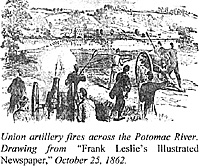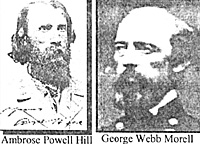"...in the face of a storm of round shot, shell and grape"
- -- Col. James Lane, CSA
Historical Setting
 Throughout September 18th, the day following the
bloody battle of Antietam, both the battered Army of
Northern Virginia and McClellan's Army of the Potomac held
their respective positions near Sharpsburg and Antietam
Creek in Maryland.
Throughout September 18th, the day following the
bloody battle of Antietam, both the battered Army of
Northern Virginia and McClellan's Army of the Potomac held
their respective positions near Sharpsburg and Antietam
Creek in Maryland.
Union artillery fires across the Potomac River. Drawing from "Frank Leslie's Illustrated Newspaper," October 25, 1862.
Desultory skirmishing would occur during the day, but no significant troop movements or combat. "Stonewall" Jackson, A. P. Hill and other Rebel officers advocated a withdrawal to Virginia, and Robert E. Lee ordered the ANV to retire to Virginia (now West Virginia) by crossing the Potomac River at Boteler's Ford. This ford (also known as Blackford's, Swearingen's or Pack Horse Ford) was critical to the withdrawal, as the Shepherdstown bridge had been destroyed earlier in the war.
General William N. Pendleton had posted his ANV Reserve Artillery on a bluff on the Virginia side overlooking Boteler's Ford to protect the exodus of Lee's army from Maryland. As V Corps under General Fitz John Porter arrived at the ford on the 19th pursuing Hill, they were pushed back by artillery fire from these guns.
Shortly before dusk, Union General Charles Griffin led a small force of 500 infantry and sharpshooters across the ford, scaled the heights, and captured 4-5 of the artillery pieces before being recalled. Pendleton reported to Lee that Federals were now on the Virginia side, and that he had lost part of his artillery. Jackson ordered his rear guard, Hill's "Light Division" of roughly 2000 men, to march 5 miles back to the ford and drive off any Federals.
On the morning of the 20th, two Northern brigades from George Sykes' division crossed the ford and moved up the heights, forming a line on the bluffs above an abandoned cement mill. Shortly afterwards, Morell's brigade under James Barnes crossed and swung to the right on a road advancing towards the village of Shepherdstown. These National troops ascended the height unseen through a ravine and deployed for battle just below the top of the bluff.
The 118th Pennsylvania, known as the "Corn Exchange Regiment," advanced beyond the crest of the heights into the open. The 737 men of this regiment were recruits who had not previously experienced combat. They would soon find out that half of their rifles were defective and would not fire.
 Ambrose Powell Hill
Ambrose Powell Hill
George Webb Morell
A. P. Hill in the meantime was rapidly advancing towards the ford. Gunfire crackled along the Union picket line as Hill approached in two battle lines, advancing through fields of corn and wheat. Artillery fire from Union guns was reported as being "a terrible storm" to the advancing Confederates. General Porter, receiving reports that his infantry was badly outnumbered, ordered a withdrawal of the three National brigades to the Maryland side. Warren retired to the canal and formed a firing line as Lovell's men waded back across the ford. Bames' regiments were still in battle line and soon also received word to retire as Hill began flanking him.
However, the commander of the 118th PA refused to withdraw until orders were received through the proper chain of command. Now alone in the fields beyond the crest, the 118th took the brunt of Hill's attack. After putting up a stout resistance for a short time and with their colonel now out of action, the regiment broke apart as it fell back under constant Rebel small arms fire.
Soon their military inexperience led to a rout, with men scrambling down the steep cliff then recrossing the ford or the dam to Maryland. Fire from Southern rifles on the bluffs above them harassed the fleeing soldiers. Men drowned in the swirling eddies of the river, fell to their deaths, or were shot in the wild scramble to recross the river.
Union losses at Shepherdstown numbered 361 combatants, 269 of which came from the Corn Exchange Regiment in its first hostile action. A. P. Hill reported losing 261 men, mostly from Federal artillery fire as they advanced, but Lee's army was now safe from further danger. The Maryland Campaign was over.
Battle of Shepherdstown Saturday, Sept. 20, 1862
Back to Table of Contents -- Charge! #1
Back to Charge! List of Issues
Back to MagWeb Master Magazine List
© Copyright 2003 by Scott Mingus.
This article appears in MagWeb.com (Magazine Web) on the Internet World Wide Web.
Other articles from military history and related magazines are available at http://www.magweb.com